Employee segmentation can help to increase engagement more than you might imagine. We tell you why and how to use it effectively.
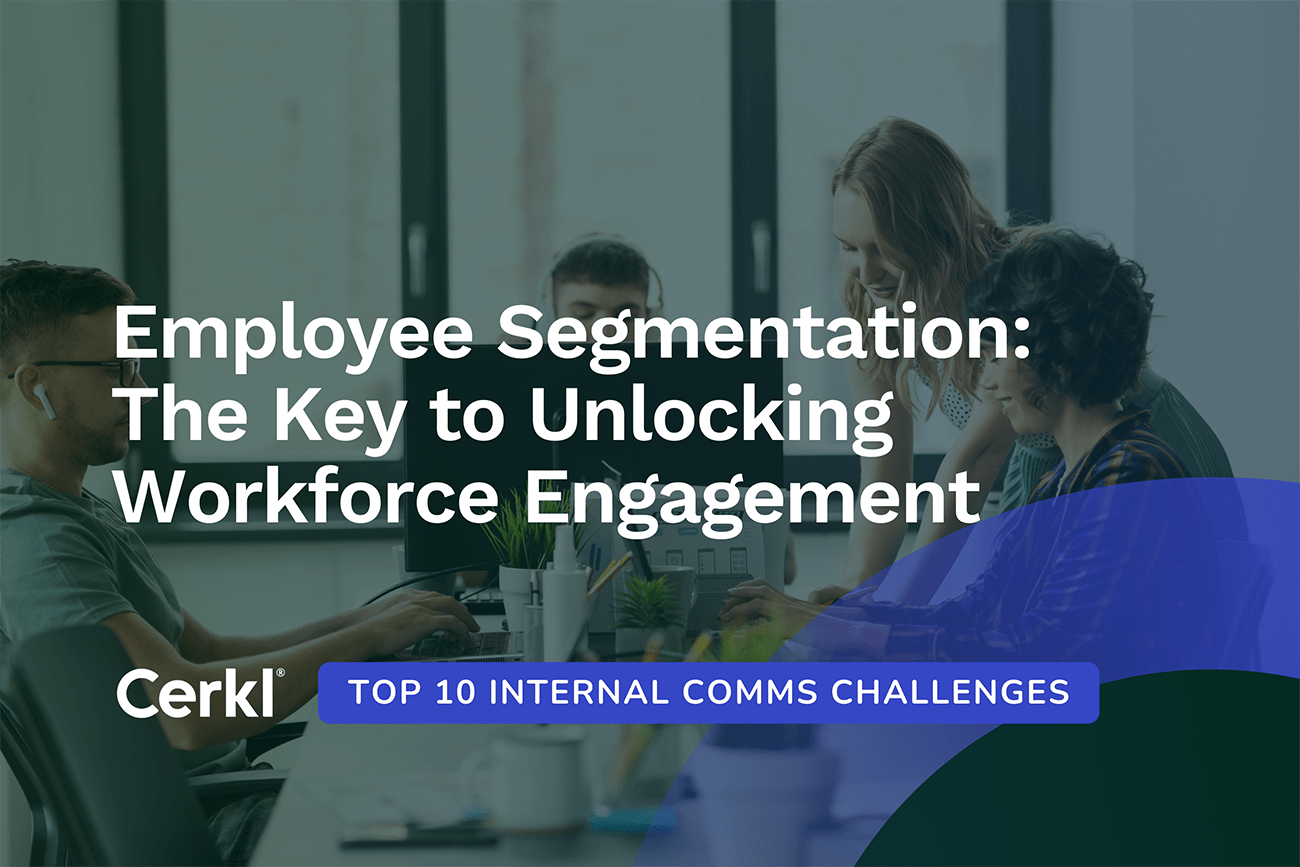
.png)
Strategy is an important component of internal communications. Ensure you’re communicating through the right channels at the right frequency with our Internal Communications Channel Audit worksheet.
Access NowIn today's dynamic workplace, keeping employees engaged is a top priority. But a one-size-fits-all approach simply won't cut it. This is where employee segmentation comes in. By strategically grouping employees based on shared characteristics, organizations can unlock a higher level of employee engagement — tailoring communication, development, and recognition efforts to their unique needs and motivations.
The Workshop 2024 Internal Communication Trends Report states that 74% of internal communicators believe their internal comms strategy needs to change in 2024, and 93% are interested in incorporating new ideas. Looking at the statistics the report provides, it’s clear that the need to improve employee engagement is a priority.
For instance:
“Studies show that proper email segmentation can increase email open rates by 203%. Through personalization, internal communicators can create relevant content and engage employees in a unique and better-than-ever email experience."
Workshop
Cerkl’s Head of Customer Success, Maddy Rieman, knows how important employee engagement is within any organization. So it’s no surprise that she identified the need to target the right audience as one of the 10 top challenges internal communicators face at our workshop held at the 11th Annual Strategic Internal Communications — West Conference in San Francisco. In the ninth post in our series, Conquering the Top 10 Internal Communications Challenges with Tactical Solutions, we expand on the importance of employee segmentation.
Before we dive into the wider world of workforce segmentation, we’re going to share Maddy’s top tips for targeting the right audience in your organization.
That’s a good start. But for those with no experience of the topic, what exactly is workforce segmentation?
We are going to identify and define the topic and tell you why it is so important. We’ll give you workforce segmentation examples and then show you why and how different employee segments are relevant. We’ll look at the challenges you will have segmenting employee information and suggest some of the best practices for efficient segmentation of employees. Finally, we’re going to share information that will show you how Cerkl Broadcast can help you and your organization get to grips with successful workforce segmentation.
Employee segmentation, also known as workforce segmentation, is the process of dividing your workforce into distinct groups based on shared characteristics. Imagine your workforce as a beautiful mosaic. Each tile represents a unique employee, with their own skills, preferences, and goals. Workforce segmentation helps us categorize these tiles based on shared characteristics.
Similarly, just as different plants have different needs (sun, water, soil type, and so on), employees thrive in different environments. When you segment employees based on their skills, experience, career goals, and other needs, you can provide the right kind of "nourishment" (development opportunities, recognition programs) to help them flourish.
The Workshop 2024 Internal Communication Trends Report predicts that the common challenges of employee engagement will make implementing employee segmentation essential in 2024. Factors to focus on include personalizing content, gathering feedback, creating branded experiences, and adding “moments of delight.”
In addition to improving employee engagement and the employee experience (EX), implementing employee segmentation can be a game-changer for employee development and people management. Recognizing that employees are individuals, and different to one another, allows us to tailor development programs, personalize communication, and strategically allocate resources. This targeted approach fuels meaningful outcomes, boosting performance, engagement, and retention as employees receive content that truly resonates with them.
Ryno Brunn, an industrial-organizational psychologist and founder of Rugged Revenue Solutions, likens workforce segmentation to “Thor's hammer – it gives your talent team the strength and ability to dominate the challenges ahead.” By grouping employees based on skills, goals, and what motivates them, we can ditch the one-size-fits-all approach. This, like segmenting customers, allows us to tailor programs, communication, and recognition to resonate with each group. The result? A more engaged and high-performing workforce.
Gonzalo Shoobridge, a senior HR specialist at The World Bank in Washington and an expert in employee engagement and EX, explains that workforce segmentation takes the same approach commonly used in marketing to target smaller groups of potential customers with similar needs. In the article, EVP & Employee Segmentation: The Days of ‘One Size Fits All’ are Over!, he says conceptually, products become work experience and target customers become employees.
We know that a one-size-fits-all approach just doesn't cut it anymore. Let's face it, a fresh grad isn't looking for the same perks as a seasoned manager. Workforce segmentation helps us understand these differences.
By recognizing different employee segments, HR can tailor initiatives to their specific needs. For instance, new hires might need onboarding programs, while high performers might benefit from leadership training. Workforce segmentation also helps pinpoint areas where specific employees lack certain skills. This allows you to develop targeted training programs to address those skill gaps.
“Authentic workforce segmentation is not the art of offering the same value proposition to all your employees but knowing what to offer to each of them. It is the art of identifying and understanding your employees’ needs and creating a unique set of benefits that deliver satisfaction to the employee, profits to the organization, and benefits for the stakeholders.”
Gonzalo Shoobridge
Often different employee segments have different performance benchmarks. Workforce segmentation allows for a more nuanced approach to performance evaluation. Additionally, it improves retention, clarifies and enhances communication, ameliorates resource strategies, and, of course, positively impacts employee engagement.
Workforce segmentation ensures you're recognizing and addressing the varied needs of diverse employee groups. This fosters a more inclusive work environment and boosts engagement. By targeting initiatives that speak directly to each segment's needs, you can create a more satisfying and motivating work experience.
Imagine offering career development workshops to high-potential employees or flexible work arrangements for parents — that's engagement magic!
Happy employees stick around, and workforce segmentation helps us address the factors that contribute to happiness for each group. Think of it as building a workplace that caters to everyone's needs, leading to a lower turnover rate and a more stable, thriving workforce.
As Ryan Brunn points out, by recognizing and acknowledging the differences between employees’ needs, capabilities, and motivations, organizations can personalize communication and recognition efforts and design targeted development programs. So, by embracing workforce segmentation, you’re well on the way to enhancing employee engagement, performance, and retention, as regardless of their positions and work descriptions, employees will begin to receive content they find appealing and useful.
“Research has continued to show that organizations that embrace workforce segmentation experience not only improve performance and engagement but also enhance the organization's financial health.”
Ryan Brunn
Workplace segmentation allows us to ditch generic company-wide emails. Instead, we craft targeted messages that are relevant and impactful for each segment. No more information overload, just clear communication that gets things done.
For employee segments to be relevant, there are certain key attributes that they need to meet, says Gonzalo Shoobridge. One of these is that they need to be accessible to employees so that you can target them through well-established, existing internal communication channels.
Be sure to remember this when implementing employee segmentation.
Upgrade your company’s internal comms to enhance employee communication
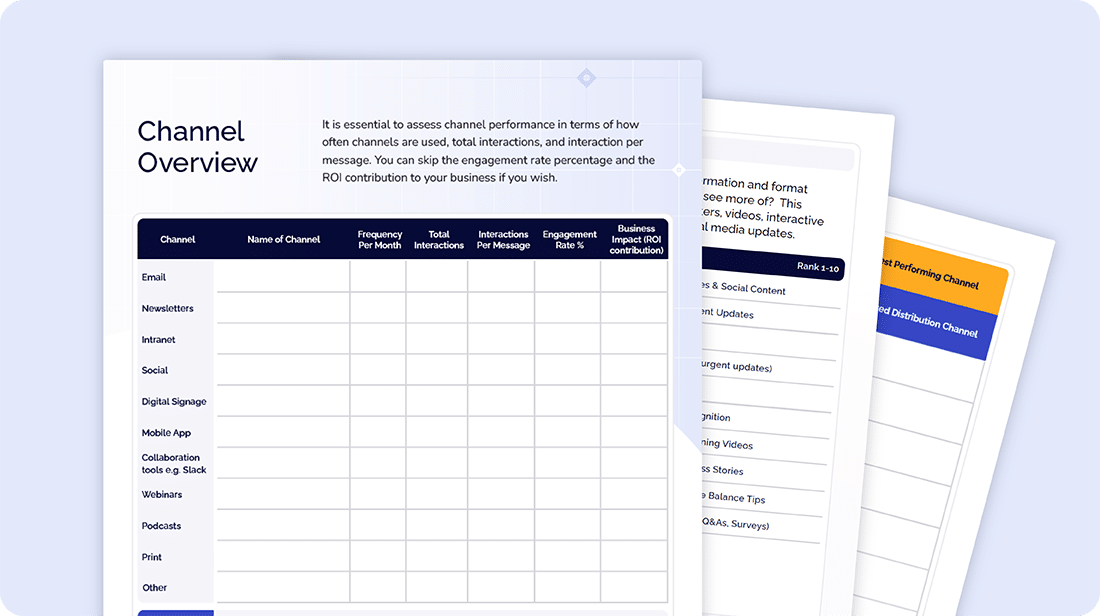
Not all programs are created equal. Workplace segmentation helps us identify which initiatives will have the most significant impact on specific employee groups. Resources like training budgets or professional development opportunities can be distributed more strategically based on the needs of each segment.
Implementing employee or workforce segmentation is all about allocating resources wisely to support employee development and well-being in the most effective way.
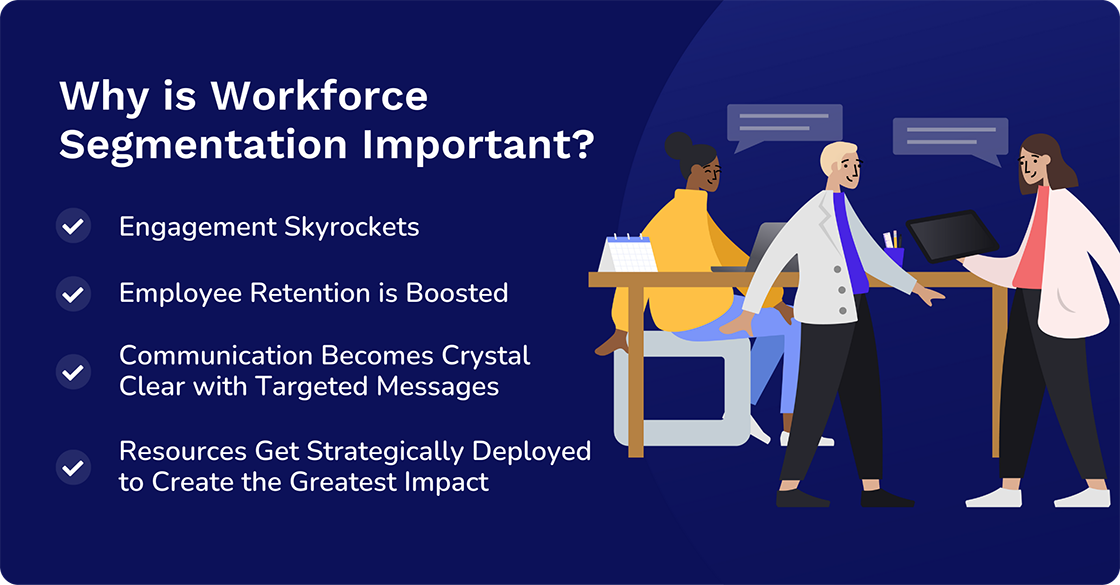
So, you’re convinced that there is a vital need for employee or workforce segmentation, but how do we segment a workforce?
Fortunately, it isn’t rocket science. Rather, it's all about gathering data! We can use surveys, performance reviews, or even existing information on demographics and job roles to extract the data we need before implementing employee segmentation.
With the data in hand, we can create segments based on all sorts of factors. Here are some examples.
Millennials, Gen Xers, Baby Boomers — each generation will have unique needs and preferences. At the same time, you will find that they have similar interests, skills, learning styles, and so on. Be sure to take this into account.
Some employees thrive in a fast-paced environment, while others prefer a more stable workload. Workforce segmentation helps cater to both!
When delivering information, it can be useful to consider learning styles. For instance, some people are visual learners who benefit from infographics, diagrams, and videos. Others are auditory learners who thrive when they have access to lectures, podcasts, and group discussions.
Marketing folks will typically have different needs than the engineering team. Similarly, those who are tech-savvy and are comfortable with the latest technology, and prefer digital communication channels, will have different needs to employees who need additional training and support to adapt to new technologies.
Because of this, leadership can benefit from tailored development programs compared to individual contributors.
Identifying high performers, moderately engaged employees, and those feeling disengaged allows us to provide targeted support to boost overall engagement.
While not relevant to all communications, it can be important to take company tenure into account when you segment employees. Typically, you will focus on communication about onboarding, mentorship, and clear career development paths for new hires. Mid-career professionals will be more interested in learning about opportunities for skill development and leadership training. Those nearing retirement will likely want to know more about programs on retirement planning and phased retirement options.
Upgrade your company’s internal comms to enhance employee communication

Workforce segmentation will only be successful if employee segments are relevant. Here are five criteria that will help ensure that your employee or workplace segmentation is a powerful tool for boosting employee engagement and creating a more positive work environment for everyone.
Each segment needs to highlight clear differences in how employees within the group respond to work and what motivates them.
For example, new hires will have different needs like onboarding and mentorship. On the other hand, mid-career professionals will be more interested in leadership training, and skills development.
Workforce segmentation helps you track the effectiveness of engagement initiatives for each segmented group.
For example, when segmenting by engagement levels you can measure the impact of specific interventions. These include recognition programs for high performers, support programs for disengaged employees, and so on.
Segments need to be large enough to warrant focused attention. At the same time, they shouldn’t be so small that they become impractical to manage.
For example, a segment of employees who enjoy volunteering might be too small for a dedicated program. However, combining them with a segment of employees interested in social impact may create a more actionable group.
Employee needs and motivations can change over time, so workplace segmentation should be flexible and adaptable.
For example, an employee might move from the new hire segment to mid-career professional as their experience grows. This will need a shift in the type of engagement initiatives they find valuable.
In this context, workforce segmentation allows you to design specific strategies to address the unique needs and motivations of each group.
For example, knowing you have a segment of employees who have been identified as introverted will allow you to create communication channels and work arrangements that cater to their preference for focused work time.

Maddy Rieman’s work experience is invaluable when it comes to navigating and conquering challenges that relate to implementing workforce segmentation.
We shared earlier that the Workshop report indicates a huge lack of employee engagement when it comes to internal emails. Maddy describes a scenario that adds reality to the stats.
The reality is that internal communicators often have to wait for IT teams to deliver them segmented lists for comms. This can take some time. If they wait too long, they can miss important time to send messages. If they don’t wait, they can end up sending more than 50 emails to every employee because they didn’t have time to wait for IT to help them segment the messages.
“This is a problem for the entire company. If you’re getting this many emails, no one can do their job and read these emails.”
That’s a bad one, but you don’t have to live with it. Here are some other challenges Maddy has identified that Cerkl Broadcast aims to meet and beat.
The problem internal communicator professionals face when targeting the right audience mostly comes in the form of the data being dirty.
“We hear this all the time: ‘I'm embarrassed to tell you this, but our people data is really dirty, multiple systems, all over the place.’ Of course, we tell them everyone is like this.”
Of course, not everybody is. But many organizations are, and many others face the risk of this happening.
Many organizations don’t have any idea what data they have available or even where that is.
“We have to help them navigate through a sea of systems with unclear relationships to other systems. This leads to data conflict across sources, for example, OSU vs Ohio State.“ That’s why it’s so important to Identify attribute inconsistencies and data that might be missing.
Many times internal communicators have to open tickets with IT. This can take many days. So, when they need to send a comm to an audience, they can’t wait.
The danger is that it can go to a wider audience than planned, if not the wrong audience. That’s where the danger of sending out more than 50 emails to every employee comes in.
Maddy says that when “we explain to these teams why comms need this, they see and understand. We negotiate with the internal stakeholders. When we face some data that shouldn’t be in Broadcast, we can work with HR and Security to bucket data (like salary ranges) or addresses vs home office.”
She highlights the importance of the General Data Protection Regulation (GDPR). Enforceable in the EU since 2018, it has become increasingly important in the U.S. Since 2023, California and several other states have enforced data privacy regulations inspired by the GDPR. Additionally, there are an increasing number of companies like Cerkl that abide by these principles, demonstrating a commitment to data privacy even in the absence of a federal law.
“So, for example, we can explain that employees can set their permissions and tracking. Thus meeting GDPR. We put the leadership's mind at ease.”
It goes further than that. When it comes to GDPR, Maddy recognizes that many companies work with “a lot of assumptions on what is possible, but they don’t realize how flexible the Broadcast system is. HR and IT might’ve told them something is impossible in the past. But now we can breathe new life into the discussion. The IC pro might have given up, but we can offer a work around or solution.”
When the Cerkl team finds data that shouldn’t be in Broadcast, they can work with HR and the security department to bucket data like salary ranges or addresses vs home office.
“We back up our internal communicators. Full stop,” says Maddy.
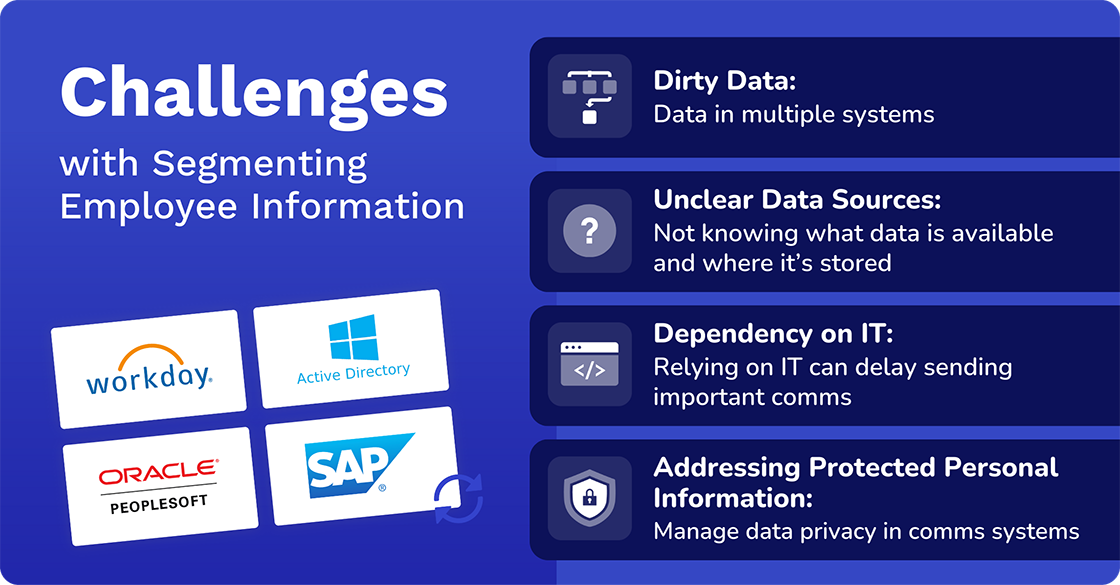
Workforce segmentation is a powerful tool for boosting engagement and performance, but it all starts with a solid foundation: data.
These are Maddy’s suggestions for internal communicators. They cover the essential first steps you need to take to unlock the power of data for effective workforce segmentation. You need to understand your systems, gather your employee data the right way, speak the tech talk, and build strong relationships within your IT and HR teams.
Most communicators don’t have any idea of what they are working with. Take the workday plus general contractors in the active directory. If they don’t know what the company has on, they cannot have the data they need.
Request a data pull of all of your data as an employee. This will provide you with the opportunity to see everything the company has access to. Then you can use this as a starting point to have these conversations with the technical teams.
Speak the same language as the tech teams otherwise you cannot have a conversation. These are some of the most important conversations in implementation. “We really push to join these conversations with our customers, but sometimes we cannot join.”
To help you with this, we have produced a blog post, Internal Communicator’s IT Glossary.
Get to know the people who help you on these teams. Get buy-in, get them on your side. They will be a huge asset. Try to make their lives easy by working with them collaboratively.
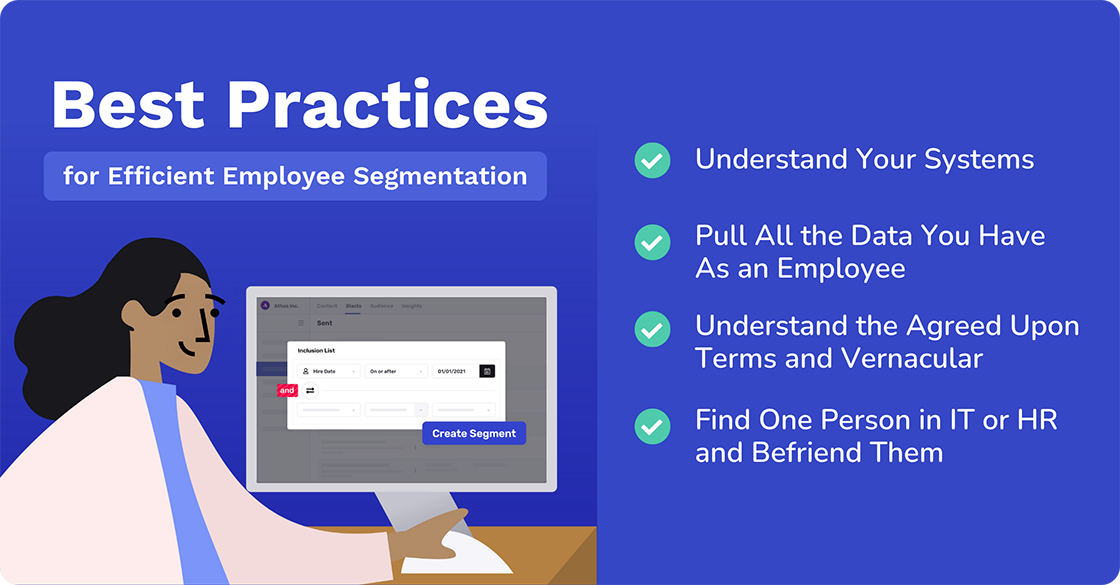
Maddy emphasizes that throughout the implementation process, Cerkl works as your liaison officer and marriage counselors, mapping templates, and being negotiators. We help organizations with formatting of documents and data and best practices.
The core of our internal communication software responsible for dynamic workplace segmentation is our Audience Manager. It makes workplace segmentation easy, enabling you to target and manage employee audiences so that you get the right message to the right people at the right time.
Broadcast also has a dynamic segments builder, together with custom data, and one time uploads, that is great for one-time messaging. It enables internal communicators to build personalized audiences instantly without needing help from IT.
Our automated AI News Digests target groups based on segments. They also enable you to learn what employees are interested in. This includes what department they are in, what office they work in, and who their manager is.
If you focus on workforce segmentation plus learning their interests, then you can target employee advocacy and other topics.
Our system syncs with their record every night. It’s real-time data. This is the most up-to-date, on-time data you will find. It’s very different from other solutions where segments are static and must be re-run. However, we have both static (for example, who attended a workshop, manual uploads, and events not in the workday) and dynamic (all live changes, for instance when someone moves teams or offices or gets promoted) data available.
There’s a sentiment that communicators are on their own, and the system is hard — and no one talks about it. They are not alone. They are a part of a community. It’s hard for everyone. Maddy identifies that being at these workshops shows that other people understand.
Cerkl certainly does understand. So, if you want to take your internal comms a step further so that you can embrace the challenges of workplace segmentation, we are here to help you. Let’s start with an internal audit that will show you how well your internal communications strategy is working. Then we can help you take it from there.
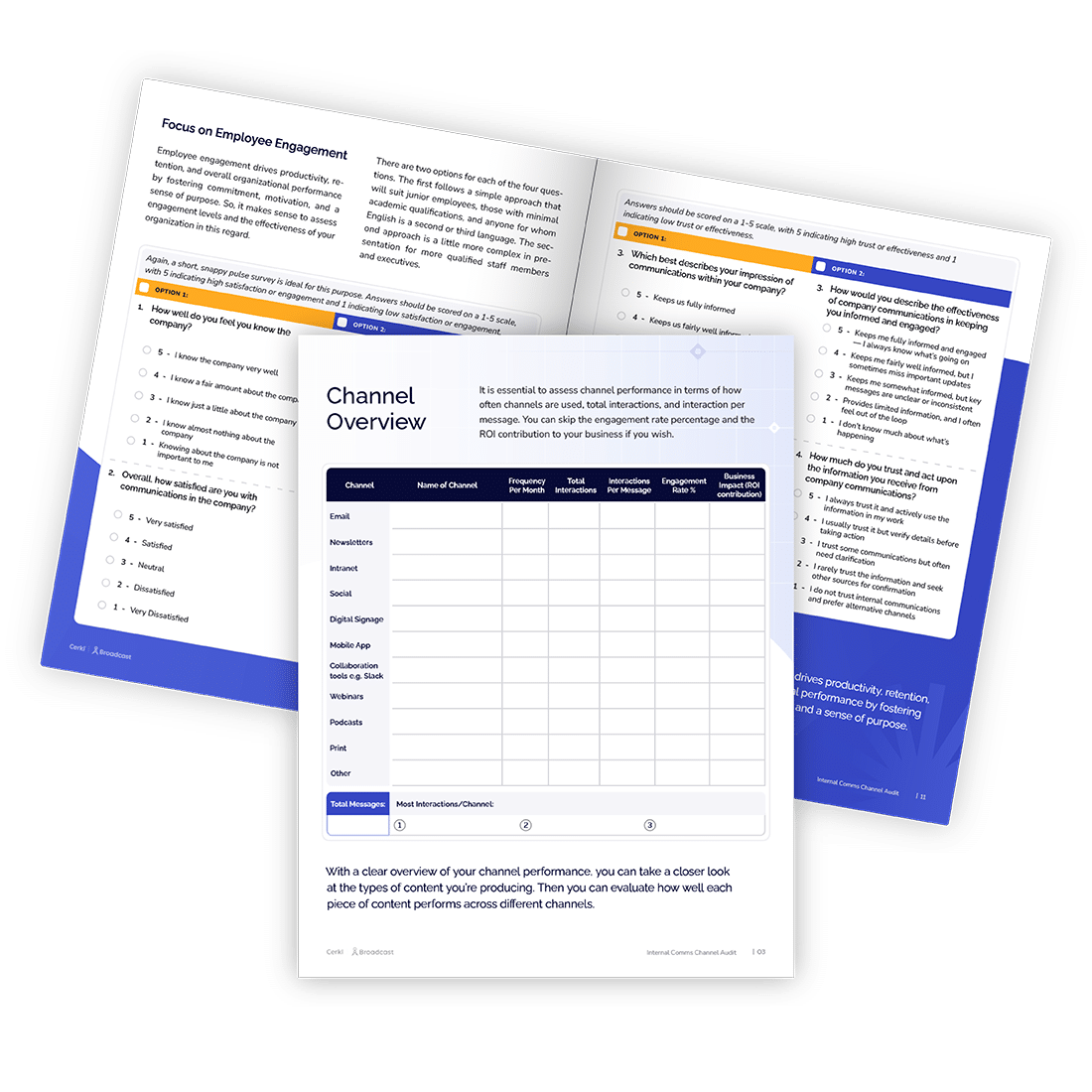
Upgrade your company’s internal comms to enhance employee communication
What is the meaning of employee segmentation? Employee or workforce segmentation groups employees with similar characteristics, like skills or work styles. This allows for targeted HR initiatives to improve engagement and performance.
What is an example of workforce segmentation? Workforce segmentation can involve creating a segment of remote workers who might need additional support with communication and collaboration tools. In contrast, on-site employees might benefit from programs focused on building team spirit and fostering in-person connections.
When should segmentation be employed? Workforce segmentation is ideal when a one-size-fits-all approach doesn't work. If different employee groups have varying needs and motivations, segmentation allows you to tailor your approach.
Why is workforce segmentation important? Workforce segmentation is important because it personalizes HR initiatives, leading to a more engaged and productive workforce. By understanding employee segments, you can allocate resources strategically and address their unique needs.

Upgrade your company’s internal comms to enhance employee communication